Doing A full Flush of Power Steering Oil with Pictures
#1
Driver School Candidate
Thread Starter
Join Date: Oct 2005
Location: ca
Posts: 21
Likes: 0
Received 0 Likes
on
0 Posts
First off, I would advise NOT doing a full flush. It is too time consuming and messy. Next time I would use the turkey baster method recycling 2 quarts thru. The LS 400 is very easy to do a full flush as the oil return line enters half way up the reservoir. Empty the reservoir, pull the return hose off and flush the system. Not so with the LS430.
I undertook this job because the steering force needed suddenly seem to have increased , the oil was black, and the reservoir needed cleaning as it was too dark to read the oil level.
The oil return on the LS430 is on the bottom (?!?) of the reservoir and makes for a messier job. The construction of the reservoir makes it impossible to get all the oil out of it before hand, so when the hoses are pulled off a lot of oil drains out.
1. Remove the air filter box. Disconnect the MAF meter wire on top by pushing DOWN on the retainer clip and pulling off. Pull the vacuum switch value (Denso 90910-12242) from the back of the lid (it is held in with screws and an "O" ring). Affix it out of the way. Now you have an empty space as shown in PICTURE A A (except the picture is really later in the procedure).
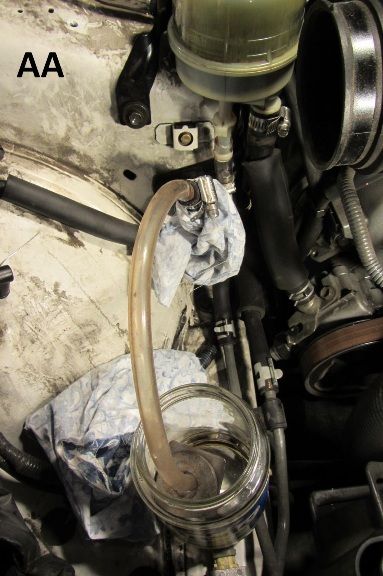
2. If you only want to do a full flush, just the smaller return hose needs to be removed from the reservoir. If you want to remove the reservoir then both have to come off. The small hose was very hard to remove and get back on. There is no reason for these hoses to be as heavy as they are (4mm sides). There is no pressure on them. 2mm sides would be good enough ( hose sizes, large then small, are: OD/IDmm 24/16; 18/10; the reservoir outlets are: OD/IDmm 16/12; 10/7).
3. The hoses were very difficult to pull down and off the reservoir so I pulled the reservoir up off the hoses. There is a metal hold down clip on the backside of the reservoir that can be released with a screw driver pushed down vertical between it and the reservoir. Then to hold it open, a large screw driver is wedged horizontal between the black metal support and clip. The reservoir can now be pulled up. I also removed the 3 bolts holding the black metal support to give more flexibility. This required lifting from the black metal support, the plastic support used for the black cable running behind the reservoir. Squeeze PARALLEl with the cable, the plastic clip underneath to release. I have no secret on how to get the hoses off without a lot of oil draining out. The space is too tight for 2 persons to work so I just used lots of rags to catch the oil.
4. With the reservoir off I tried cleaning it with gunkoff then acetone. Did not work. The hole in the top is only 12mm. Too small to get any kind of a brush thru. I did make a small swab of dense plastic foam on the end of a rod but it was hard to work it against the insides. So I scrapped only a small inside section with a small L shaped copper rod smashed flat on the end and filed curved to match the inside wall. The reservoir was thoroughly rinsed with paint thinner then acetone to remove any loose material. The result is in PICTURE BB.
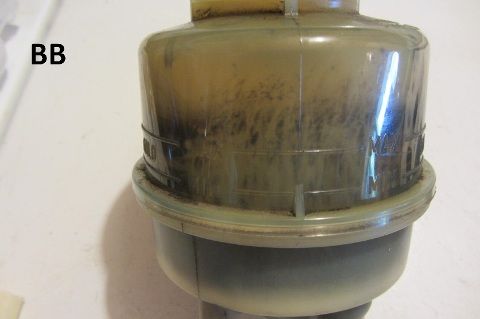
5. The reservoir was refitted and the large hose put on and clamped. The return on the reservoir is plugged off using some plastic hose and a cut off 3/8 bolt which is clamped (PICTURE CC). The return hose is feed to a container (PICTURE AA). The system can now be flushed.
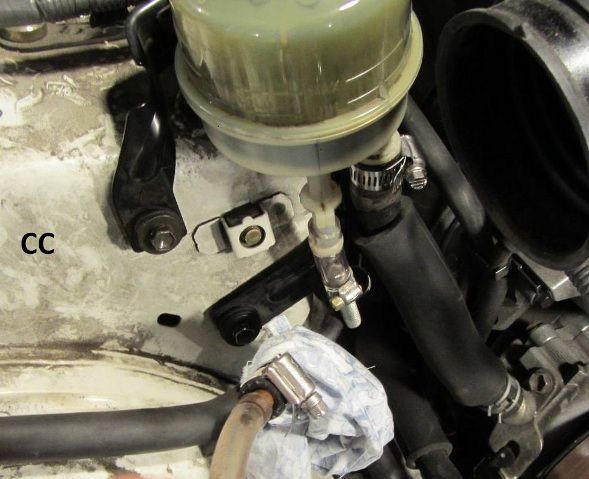
6. With the setup as in PICTURE AA and the reservoir full, the steering wheel is turned side to side (with front of car jacked up) to pull oil in from the reservoir to the rack. The steering pump can be turned (clockwise) by hand after the belt is loosened (no need to start the car). This forces oil into the rack. Between turning the pump and the steering wheel, after 1 quart of oil it came out clean.
7. To put the return hose on, the oil is suck out of the reservoir but some still remains. The clamp holding the bolt is removed and large plastic tubing is slipped over the smaller plastic tubing holding the bolt (PICTURE DD). A thin, small screw driver is inserted into the large tubing to reach the threads on the bolt. It is pushed out of the smaller tubing allowing the rest of the oil to drain (PICTURE EE). The small return hose is put on the reservoir (with difficulty). Fill the reservoir to the fill line.
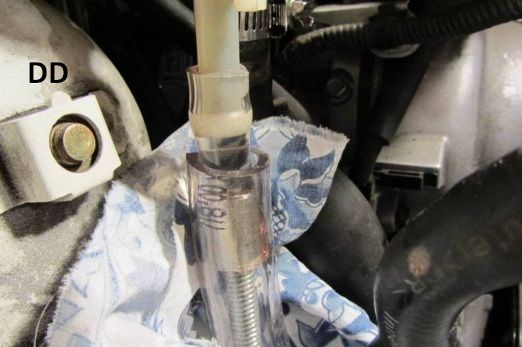
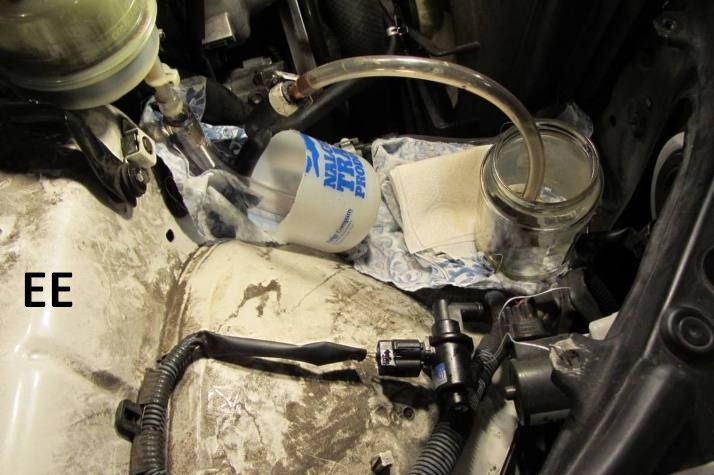
I undertook this job because the steering force needed suddenly seem to have increased , the oil was black, and the reservoir needed cleaning as it was too dark to read the oil level.
The oil return on the LS430 is on the bottom (?!?) of the reservoir and makes for a messier job. The construction of the reservoir makes it impossible to get all the oil out of it before hand, so when the hoses are pulled off a lot of oil drains out.
1. Remove the air filter box. Disconnect the MAF meter wire on top by pushing DOWN on the retainer clip and pulling off. Pull the vacuum switch value (Denso 90910-12242) from the back of the lid (it is held in with screws and an "O" ring). Affix it out of the way. Now you have an empty space as shown in PICTURE A A (except the picture is really later in the procedure).

2. If you only want to do a full flush, just the smaller return hose needs to be removed from the reservoir. If you want to remove the reservoir then both have to come off. The small hose was very hard to remove and get back on. There is no reason for these hoses to be as heavy as they are (4mm sides). There is no pressure on them. 2mm sides would be good enough ( hose sizes, large then small, are: OD/IDmm 24/16; 18/10; the reservoir outlets are: OD/IDmm 16/12; 10/7).
3. The hoses were very difficult to pull down and off the reservoir so I pulled the reservoir up off the hoses. There is a metal hold down clip on the backside of the reservoir that can be released with a screw driver pushed down vertical between it and the reservoir. Then to hold it open, a large screw driver is wedged horizontal between the black metal support and clip. The reservoir can now be pulled up. I also removed the 3 bolts holding the black metal support to give more flexibility. This required lifting from the black metal support, the plastic support used for the black cable running behind the reservoir. Squeeze PARALLEl with the cable, the plastic clip underneath to release. I have no secret on how to get the hoses off without a lot of oil draining out. The space is too tight for 2 persons to work so I just used lots of rags to catch the oil.
4. With the reservoir off I tried cleaning it with gunkoff then acetone. Did not work. The hole in the top is only 12mm. Too small to get any kind of a brush thru. I did make a small swab of dense plastic foam on the end of a rod but it was hard to work it against the insides. So I scrapped only a small inside section with a small L shaped copper rod smashed flat on the end and filed curved to match the inside wall. The reservoir was thoroughly rinsed with paint thinner then acetone to remove any loose material. The result is in PICTURE BB.

5. The reservoir was refitted and the large hose put on and clamped. The return on the reservoir is plugged off using some plastic hose and a cut off 3/8 bolt which is clamped (PICTURE CC). The return hose is feed to a container (PICTURE AA). The system can now be flushed.

6. With the setup as in PICTURE AA and the reservoir full, the steering wheel is turned side to side (with front of car jacked up) to pull oil in from the reservoir to the rack. The steering pump can be turned (clockwise) by hand after the belt is loosened (no need to start the car). This forces oil into the rack. Between turning the pump and the steering wheel, after 1 quart of oil it came out clean.
7. To put the return hose on, the oil is suck out of the reservoir but some still remains. The clamp holding the bolt is removed and large plastic tubing is slipped over the smaller plastic tubing holding the bolt (PICTURE DD). A thin, small screw driver is inserted into the large tubing to reach the threads on the bolt. It is pushed out of the smaller tubing allowing the rest of the oil to drain (PICTURE EE). The small return hose is put on the reservoir (with difficulty). Fill the reservoir to the fill line.


Last edited by w1ayne; 02-07-14 at 02:55 PM. Reason: replace lost image
#6
I found pictures of this process on the GS forum but for a GS300, and that has a different reservoir that seems much more cooperative. I did the full flush and decided against trying to clean the reservoir side walls. To get the hose off I found it mandatory that you remove the reservoir from the bracket as described above. THen lightly gripping the hose with the jagged part of plyers I wiggled the hose back and forth with some downward pressure. I also took some of the drained ATF and squirted it on the hose for lubrication. Did the reverse for reinstall and that went very smoothly. Remove your airbox for more room ( GS430 anyway). It takes little time and gives you room to put things and rags to soak up spilled fluid.
I used a mix mizer from walmart to remove the fluid reservoir ATF. Its a big syringe and works great $3.95 at Walmart on the back wall by auto service. Instead of clamps I used brass hose barbs or Mips in 3/8 inside diameter. One Mips splicer to connect directly to the return hose and a long tube to the drain container. One short piece of plastic tubing with Brass Hose Barb and then a matching cap to connect to the return of the reservoir. This acts as the plug for the now open return line on the reservoir and makes it easy to drain at the end of the process when you want to reattach the return the line. You simply unscrew the cap and the fluid drains into your container. Pics are in the 2GS forum. The parts cost about $25 from Home Depot and I now have a custom setup ready to use again.
I did have a problem with Air getting into the system. I had my son turning the wheel as I poured in ATF. SInce I did not clean the reservoir I had trouble eyeing how much fluid to put in and it went dry as he turned the wheel sucking air into the system. Luckily I bought two quarts of ATF so we just continued with better communication signals, and got rid the air. You can actually watch the air bubbles come out into the return ( drain tubing). I then did the bleed procedure of turning the wheels back and forth after everything was back together prior to returning the car to the ground. Started the car, turned the wheels about 5 times, checked the fluid level and it stayed where it was.
As far as the ATF I went with Valvoline Max Life, there are many threads on what to use and some negatives on synthetic. I have used the Maxlife in the Transmission with no problems twice now or 100K of driving.
I used a mix mizer from walmart to remove the fluid reservoir ATF. Its a big syringe and works great $3.95 at Walmart on the back wall by auto service. Instead of clamps I used brass hose barbs or Mips in 3/8 inside diameter. One Mips splicer to connect directly to the return hose and a long tube to the drain container. One short piece of plastic tubing with Brass Hose Barb and then a matching cap to connect to the return of the reservoir. This acts as the plug for the now open return line on the reservoir and makes it easy to drain at the end of the process when you want to reattach the return the line. You simply unscrew the cap and the fluid drains into your container. Pics are in the 2GS forum. The parts cost about $25 from Home Depot and I now have a custom setup ready to use again.
I did have a problem with Air getting into the system. I had my son turning the wheel as I poured in ATF. SInce I did not clean the reservoir I had trouble eyeing how much fluid to put in and it went dry as he turned the wheel sucking air into the system. Luckily I bought two quarts of ATF so we just continued with better communication signals, and got rid the air. You can actually watch the air bubbles come out into the return ( drain tubing). I then did the bleed procedure of turning the wheels back and forth after everything was back together prior to returning the car to the ground. Started the car, turned the wheels about 5 times, checked the fluid level and it stayed where it was.
As far as the ATF I went with Valvoline Max Life, there are many threads on what to use and some negatives on synthetic. I have used the Maxlife in the Transmission with no problems twice now or 100K of driving.
Trending Topics
#8
Now that I have learned the importance of this I will be doing the "turkey baster" with every oil change to keep things fresh in all my cars.
#10
I've tried the turkey baster with not so great results. The first negative was my GF became furious after I told her I sacrificed her kitchen utensil. The second negative was the baster squeeze bulb would not seal correctly and I'd just end up with a mess regardless how careful I tried to be. (There's also a thread on here of someone piercing a strainer or something near the bottom of the PS reservoir with the pointed/sharp tip of the baster?)
What I've been using for the last year is to use one of the Plews fluid pumpers similar to when pumping gear oil into the diff. The pump can be found here...
When I pump it out, I'm usually able to remove approximately 10oz? DO NOT PUMP IT OUT WHILE VEHICLE IS RUNNING, AND ENSURE IT'S FULL TO PROPER LEVEL BEFORE STARTING THE ENGINE.
In reality, it's not a lot compared to what the total capacity of the system is...guessing total capacity is over 3 quarts? I then refill (being careful to take into account the side of the reservoir to view fluid level is probably STAINED), to appropriate level, and do it again after a month of driving (I only drive it on weekends).
FWIW, I started doing this only about 8 months ago and am still sucking out very dark red/brown fluid. I have about 180k on the odometer.
What I've been using for the last year is to use one of the Plews fluid pumpers similar to when pumping gear oil into the diff. The pump can be found here...
When I pump it out, I'm usually able to remove approximately 10oz? DO NOT PUMP IT OUT WHILE VEHICLE IS RUNNING, AND ENSURE IT'S FULL TO PROPER LEVEL BEFORE STARTING THE ENGINE.
In reality, it's not a lot compared to what the total capacity of the system is...guessing total capacity is over 3 quarts? I then refill (being careful to take into account the side of the reservoir to view fluid level is probably STAINED), to appropriate level, and do it again after a month of driving (I only drive it on weekends).
FWIW, I started doing this only about 8 months ago and am still sucking out very dark red/brown fluid. I have about 180k on the odometer.
Last edited by LS430inDE.; 03-31-21 at 05:45 PM.
#11
Intermediate
I've tried the turkey baster with not so great results. The first negative was my GF became furious after I told her I sacrificed her kitchen utensil. The second negative was the baster squeeze bulb would not seal correctly and I'd just end up with a mess regardless how careful I tried to be. (There's also a thread on here of someone piercing a strainer or something near the bottom of the PS reservoir with the pointed/sharp tip of the baster?)
What I've been using for the last year is to use one of the Plews fluid pumpers similar to when pumping gear oil into the diff. The pump can be found here... Plews fluid pump
When I pump it out, I'm usually able to remove approximately 10oz? DO NOT PUMP IT OUT WHILE VEHICLE IS RUNNING, AND ENSURE IT'S FULL TO PROPER LEVEL BEFORE STARTING THE ENGINE.
In reality, it's not a lot compared to what the total capacity of the system is...guessing total capacity is over 3 quarts? I then refill (being careful to take into account the side of the reservoir to view fluid level is probably STAINED), to appropriate level, and do it again after a month of driving (I only drive it on weekends).
FWIW, I started doing this only about 8 months ago and am still sucking out very dark red/brown fluid. I have about 180k on the odometer.
What I've been using for the last year is to use one of the Plews fluid pumpers similar to when pumping gear oil into the diff. The pump can be found here... Plews fluid pump
When I pump it out, I'm usually able to remove approximately 10oz? DO NOT PUMP IT OUT WHILE VEHICLE IS RUNNING, AND ENSURE IT'S FULL TO PROPER LEVEL BEFORE STARTING THE ENGINE.
In reality, it's not a lot compared to what the total capacity of the system is...guessing total capacity is over 3 quarts? I then refill (being careful to take into account the side of the reservoir to view fluid level is probably STAINED), to appropriate level, and do it again after a month of driving (I only drive it on weekends).
FWIW, I started doing this only about 8 months ago and am still sucking out very dark red/brown fluid. I have about 180k on the odometer.
#12
A lot of people remove and refill, then drive for a day or two and do it again. This is a bit slower but the removal/replace of old fluid takes a couple minutes at most so either way isn't a big deal, I just wanted to get it done .
#13
Intermediate
Yes, but it can also go a lot faster if you want. When I change mine out, I make sure the engine is already warmed up. Turn it off, suck out the old, put in some new, then start the car and turn the wheel from lock right to lock left a couple times. Turn the car off and repeat removing fluid and filling up again until the fluid lightens up.
A lot of people remove and refill, then drive for a day or two and do it again. This is a bit slower but the removal/replace of old fluid takes a couple minutes at most so either way isn't a big deal, I just wanted to get it done .
A lot of people remove and refill, then drive for a day or two and do it again. This is a bit slower but the removal/replace of old fluid takes a couple minutes at most so either way isn't a big deal, I just wanted to get it done .
Why isnt this smart to do with the engine running? Does it suck air in even if the steering wheel isnt touched?
#14
If the car is running, the pump can engage and suck in air. Not sure if the pump moves a small amount of fluid even if steering is stationary or not but bleeding is a pain so not worth it.
#15
Intermediate




